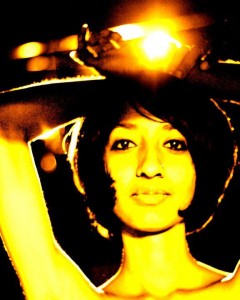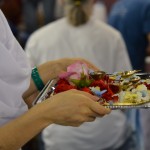How does one describe the sound of a soul’s yearnings?
That’s how it feels to try to describe “Radio Nada,” the latest album from the Maine-reared, Brooklyn-ripened singer/songwriter who is known simply as Devadas. The name, given to then Andrew Labrecque by his guru, Mata Amritanandamayi Devi (aka Amma, the “Hugging Saint”), means Servant of God.
Somehow “Servant of God” seems far more fitting here than singer/songwriter, as “Radio Nada” seems to scrape a little dust off your soul with every track.
Released February 23 and now available in all the usual places (see links below), “Radio Nada” is a study in contrasts, standing out both for its striking simplicity and its unobtrusive intricacy. It is simultaneously stripped-down and complex. Dark yet hopeful. Its shadowy nuances reveal an understated, almost inexplicable radiance. Like light emanating from a dusty bulb.
With an even split of ancient mantras juxtaposed with inspired modern lyricism, Devadas guides us along an undulating river of slow, steady traditional chants interspersed with a Ferris wheel of English songs spun from swallowed moons and wretched roses. If you really listen, “Radio Nada” will bend your mind, then crack open your heart. Then it will do it all over again.
“I don’t want to live forever, I’m just waiting for the sun. I have seen a million moons and I’ve swallowed every one…”
One of the things we love about this album is how Devadas has intermingled traditional call-and-response kirtan with original songs culled from the depths of his own seeking soul. He has resisted the overplayed urge to shoehorn English lyrics into the middle of sacred mantras and has instead effectively integrated the two forms while keeping them separate. This lets these powerful mantras speak for themselves without being muddied up with someone’s English interpretation of them. And it lets his fantastical dream-like poeticism shine, in all its shadowy spin-your-headiness. This is a good thing.
We asked Devadas what compelled him to make a hybrid CD like this, which is not nearly as common as the mantra-fusion trend where English and Sanskrit try to coexist within a song.
“The songs seemed to fit together well with the traditional kirtan and I thought they might give a clearer picture of who I am and where I’m coming from, and maybe make the whole story deeper,” he said. “Not that my story’s so important; it just happens to be what I’m burning through and what I figure I ought to be showing.”
“Sleep sleep wounded child. Sun in your mouth, stars in your eyes. The world awaits like a lioness pacing, so dream dream dream.”
It could easily fall apart into a disjointed mumbo-jumbo of maniacal musings mingled with mantras, but somehow it all works. Maybe it’s the steady underlying rhythm and bass that reappears track in and track out like an old friend greeting you, whether the subject is Radharani, Queen of the Gopis, or a wounded child with the sun in her mouth and stars in her eyes. Maybe it’s the recurring soundscape of hypnotic electronica and understated guitar. Or maybe it’s the constancy of Devadas’ haunting vocals, rife with the earnestness of a young Bob Dylan or a less raspy Tom Waits. Something, somehow, keeps the brilliance of these disparate tracks from dissipating into the brooding dreamscape on which they appear to be built.
It’s one of those things that’s hard to put your finger on, but in the end it really doesn’t matter because you know it’s in the right spot by the way you feel afterward…
“Through darkest shadow I disappear, through smoke and dream I ride. Where all angels fear to move in the wastelands I do hide. Built up a fire and I burned it all down. Slept in a bed built under the ground. Waiting still, this weary heart…the wretched for the Rose.”
There’s an unmistakable darkness to this album, a ruminative mood that bleeds through on every track. Even the chants to Radharani, Narayana, and Amma, with so much potential for ecstatic abandonment and joy, are grounded in a heart-felt melancholy, a yearning that seems never quite fulfilled, a seeking not quite satisfied. One cannot help but be affected by it.
Does “Radio Nada” represent the dark side of this urban Jedi hipster-wallah? Here’s how Devadas responded to that query: “To me, they’re songs about searching, about questioning, about falling down, trying to get back up, trying to figure things out. It’s hard to say if that’s a ‘shadow-side’… Maybe it is? To me I’m just trying to show my ‘human side’ in a truthful way.”
Ah, authenticity. How very refreshing…
All we can say is Bravo, Devadas. You’ve done it again.
We say this because his last album, “Brooklyn Mellows,” is one of our all-time favorite kirtan CDs. So much so that it literally got stuck in our car CD player from playing it so much. “Brooklyn Mellows” is pure bhakti brilliance — a thoroughly delicious double-disc set that devotes an entire CD to iterations of the Hare Krishna Maha Mantra in the style of the late great vaishnava Aindra Das, who famously started the 24-hour kirtans in Vrindavan, India and published an epic series of live CDs called “Vrindavan Mellows.”
“Radio Nada” picks up where “Brooklyn Mellows” ended and dives deeper, revealing more of the humanness of the God-Servant than even he may realize. We even detected a subtle sonic nod to the carnivalesque theme of “Brooklyn Mellows,” which featured soundbites recorded at New York’s legendary amusement park, Coney Island. Listen carefully and you’ll hear the tinkle of the carnies’ bells embedded in “Radio Nada’s” tracks …
“Rain …it keeps falling it’s filled the canal where we used to play, tossing coins in a well. All of that’s gone now, it’s a different world changing. It’s midnight and soaking, the streets are all empty.”
Devadas has just launched a rare little tour in Northern California before he heads back home to the East Coast for gigs in his home ‘hood of Scarborough, Maine and other New England hot spots. If you get a chance to sing with him live, don’t miss it: it will be some of the most moving kirtan you will experience.
But don’t take our word for it, take this for as example, recorded a few years ago at Vermantra:
See also: www.devadasmusic.com
Buy “Radio Nada” at CDBaby, Amazon, or iTunes (way better for the artist than streaming!)
___________________
The Bhakti Beat welcomes your support! We are non-commercial and not-for-profit, a free service to the bhakti community that is completely self-funded save for the loving contributions of Bhakti Beaters like you. Your support is critical — please share the Beat with your bhakti peeps, connect with us on social media (links below), and consider a one-time or recurring donation (DONATE HERE) to help us keep this bhav boat afloat. All contributions are used exclusively to cover the direct expenses of bringing you News, Reviews, Interviews and Videos from the kirtan and mantra-music world. Thank you from the bottom of our bhav brain, heart and soul. In loving service...
Hare Krishna Hare Krishna Krishna Krishna Hare Hare Hare Rama Hare Rama Rama Rama Hare Hare Dear Lord, kindly engage me in your service. Follow The Bhakti Beat on facebook Follow The Bhakti Beat on twitter Subscribe to our YouTube channel Follow Bhakti_Beat_Brenda on Instagram Find us on Google+

















































